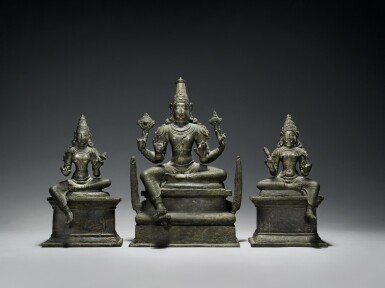Indian, Himalayan & Southeast Asian Works of Art
Indian, Himalayan & Southeast Asian Works of Art

Property From a New York City Collection
A Copper Alloy Figure of Vishnu, Bhudevi and Sridevi, South India, Vijayanagar, circa 14th/15th Century
Auction Closed
September 20, 05:33 PM GMT
Estimate
200,000 - 300,000 USD
Lot Details
Description
Property From a New York City Collection
A Copper Alloy Figure of Vishnu, Bhudevi and Sridevi
South India, Vijayanagar, circa 14th/15th Century
Height of tallest 15 in. (38.1 cm), (3)
Vishnu seated in lalitasana on an oval cushion supported on the tiered molded pedestal, his primary hands in abhaya and katakahasta mudra, his upper hands holding the wheel, or law, and the conch shell, and wearing a long pleated dhoti, broad waist band, upavita, foliate armlets, necklaces, and tapering cylindrical crown, his face with smiling benevolent expression; his wives seated in lalitasana with one hand holding a lotus, the other poised in katakamukha mudra, wearing dhotis, jewelry, and tiered conical crown, Sridevi with breast-band and disk earrings, all three figures with foliate nimbi attached behind their heads
Pan-Asian Collection.
Collection of Alice Boney (1901-1988).
Sotheby's New York, 2nd June 1992, lot 85.
Vishnu is seated here at center with an erect posture, signifying his majesty and power. He is flanked by his two consorts Bhudevi and Sridevi, who sit by his side in smaller scale. In his secondary hands he carries Lord Vishnu’s implements – the conch and discus – which represent his complete control over all the elements of the universe. His consorts, each holding lotus flowers, signify both spiritual and earthly abundance.
The art of the Vijayanagar period, which spanned the fourteenth through the sixteenth centuries in South India, shows continuity with the earlier styles of the Chola Dynasty (9th-13th centuries). As the Muslim forces established rule in Northern India in the thirteenth century, the South defiantly reaffirmed their commitment to Hindu ideals and practices. The main city bearing the name of the period, Vijayanagar, or “City of Victory”, is a declaration of the South’s triumph in overcoming a period of considerable chaos caused by the Northern invaders, and their link to the successful Chola dynasty was an affirmation that political, economic and cultural success would continue.
Many of the artistic practices, including the making of metal deities perfected in technique and style during the Chola reign, flourished during the Vijayanagar period. Often created in groups, this monumental triad shows a continuity of the casting tradition of cire perdue or lost wax. Wax figures would be encased in clay molds before a molten metal mixture of copper alloy poured through apertures. The mold would later be broken to reveal the cooled metal figure, and in doing so, ensuring that no two cast images could be identical. The sculptures were then finished with intricate chasing and detailing, producing devotional and artistic masterpieces such as this triad.
Unlike the naturalism present in the sculptures from the Chola dynasty, Vijayanagar bronzes are more heavily stylized in line, texture and design. The naturalism of the previous era is replaced with a still and motionless quality, as if the figures were frozen in time. The faces and bodies are frontal and straight, with every detail, such as the lotus flowers held by the two consorts, arranged with deliberateness. Although the figures still retain corporeal suppleness, particularly the female bodies, the style is mannered and intentional.
The known examples of Chola and Vijayanagar groups of copper casts still intact are rare. Almost all of them depict the loving couple Uma and Shiva and other Shaivite couples. Larger groups are even more rare, with two other known examples featuring Vaishnavite sets including Krishna and his two consorts, Satyabhama and Rukmini. The first, which is in a private collection is illustrated in The Chinese Porcelain Company: A Dealer’s Record 1985-2000, New York, 2000, pp. 24-25 and the second, which includes a fourth figure of a garuda from the Los Angeles Museum of Art, is illustrated in Vidya Dehejia, The Sensuous and the Sacred: Chola Bronzes from South India, New York, 2003, pp. 200-201, cat. no. 52. No other triad from the Chola or Vijayanagar period depicting Vishnu with his loving consorts is known, making the present sculpture, which is in near perfect condition, a great rarity and one of exquisite beauty.
